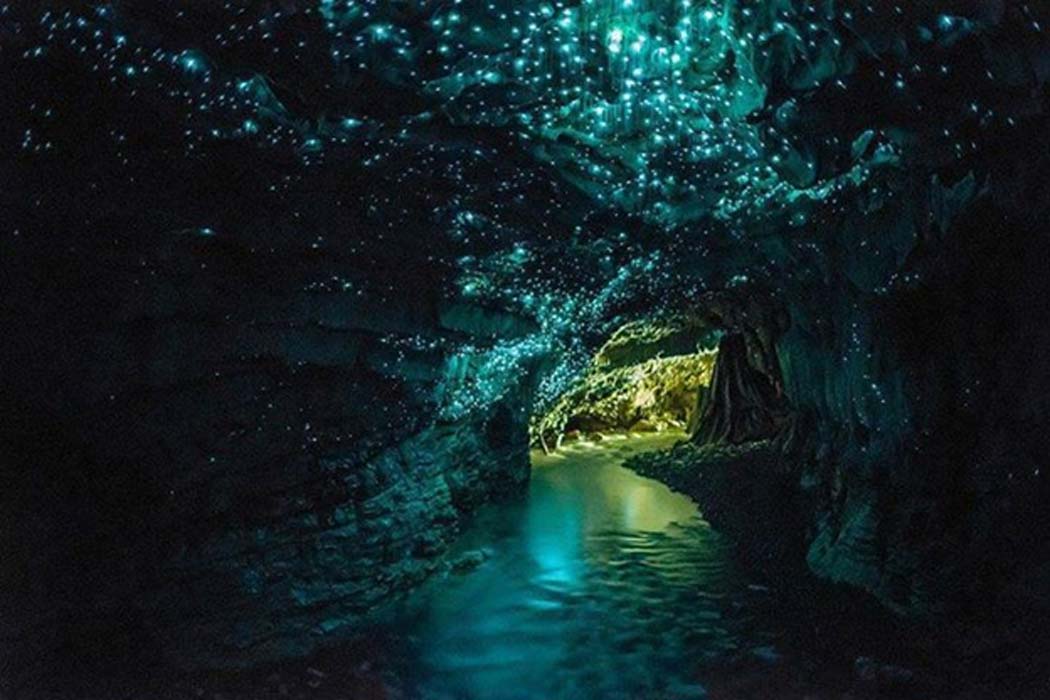Living Lights: Majestic Glowworm Cave of Waitomo is Like a Starry Night
The Waitomo Glowworm Cave is a magnificent subterranean cave system in Waitomo, New Zealand, which as its name suggests, is renowned for its glowworm population. The glowworms, sometimes referred to as fireflies, belong to a species unique to New Zealand and are not found anywhere else in the world. As a result of the light emitted by these tiny creatures, the ceiling of the cave looks as though it were lit by countless stars. Thousands of visitors flock to the Waitomo Glowworm Cave every year to witness this beautiful spectacle with their own eyes.
Waitomo – The Discovery
The Waitomo Glowworm Cave is part of the Waitomo Caves System, which includes the Ruakuri and Aranui Caves. The name Waitomo is said to be a combination of two Māori, ‘wai’, which means ‘water’, and ‘tomo’, which means ‘a hole in the ground’. The Waitomo Caves System was first extensively explored in 1887/8. The story goes that in that year, Tane Tinorau, the local Maori chieftain of the Kawhia Tribe, led an attack on a neighbouring tribe. After defeating them, a hunter was sent to look for food, when he stumbled across the Waitomo Caves System. According to another story, the local Māori people were already aware of the existence of this network of caves, though they did not explore it extensively.
First Explorations
Tane Tinorau, accompanied by Fred Mace, an English surveyor, began to explore the caves. The chief and the surveyor entered the cave on a raft made of flax flower stalks, and had only a torch to light their way. As they were exploring the cave, they realized that there was light reflecting off the water. Looking up, the two explorers were stunned to find the ceiling of the cave dotted with sparkling blue lights, which they later identified as coming from glowworms. Tinorau and Mace were also able to explore the lower levels of the cave on foot during this time, where they discovered many beautiful natural limestone formations, such as stalactites and stalagmites. The two men would return many more time to further explore the caves system.
Soon after the cave was discovered, it was mapped by government surveyors, and Tinorau opened it to the public. Tinorau and his wife, Huti, also served as guides to the tourists who visited the cave. In 1904, the Waitomo Glowworm Cave and its surrounding area were acquired by the government of New Zealand. It was only in 1990 that the cave was returned to the descendants of the original Māori owners, who now participate in its development and management, and receive a share of the revenue generated from the cave.
The Star Attraction
The cave’s star attraction is its glowworms, which are of a species known as Arachnocampa luminosa, unique to New Zealand. Hence, they are also known commonly as the New Zealand glowworm. As a matter of fact, this creature is not at all a type of worm, but the larvae stage in the lifecycle of a fungus gnat. While they look quite grotesque in the daylight, in the darkness, their brilliant shine is magnificent.
The glowworms are able to glow in the dark thanks to bioluminescence, which is made possible by the reaction between the chemicals released by the glowworms and the oxygen in the air. The glowworm’s bioluminescence serves a number of important purposes. First, the light emitted by the glowworms helps them obtain food, by attracting other insects to them. As these insects fly towards the light, they get stuck in the sticky lines produced by the glowworms, and are then consumed. In addition, the glow functions as a means for the glowworms to burn off its waste. Finally, the glow is also meant to deter other predators from eating them.

The sticky lines produced by the glowworms to capture their prey (murdocke23/flickr)
Whilst the Arachnocampa luminosa has a life span of up to 11 months, 9 of them are spent as larvae. The adult gnat, which looks like a large mosquito, can only live for about 3 days, during which its sole purpose is to reproduce.
Top image: The Waitomo Glowworm Cave, New Zealand (flickr)
By: Wu Mingren
References
Cooper, A., 2018. Top 10 facts about Waitomo Caves. [Online]
Available at: https://www.newzealand.com/uk/article/top-10-facts-about-waitomo-caves/
Encyclopedia of Life, 2018. Arachnocampa luminosa. [Online]
Available at: http://eol.org/pages/719231/details
Fox-Skelly, J., 2016. New Zealand's Waitomo Cave is Illuminated by a Strange Light. [Online]
Available at: http://www.bbc.com/earth/story/20160826-the-baby-gnats-that-light-up-a-new-zealand-cave
Michelle, 2018. Waitomo Glowworm Caves. [Online]
Available at: https://www.atlasobscura.com/places/waitomo-glowworm-caves
www.waitomo.com, 2018. Glowworm Lifecycle. [Online]
Available at: http://www.waitomo.com/waitomo-information/pages/glow-worm-life-cycle.aspx
www.waitomo.com, 2018. Waitomo Glowworm Caves. [Online]
Available at: http://www.waitomo.com/Waitomo-Glowworm-Caves/Pages/default.aspx
www.waitomocaves.com, 2018. Waitomo Glowworm Cave. [Online]
Available at: https://www.waitomocaves.com/downloads/Glowworm%20Cave.pdf



















